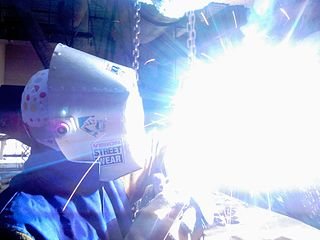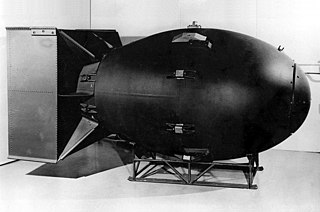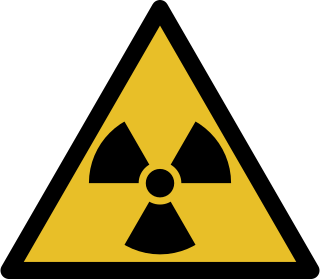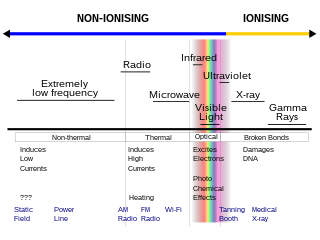Background radiation is a measure of the level of ionizing radiation present in the environment at a particular location which is not due to deliberate introduction of radiation sources.

Radiation therapy or radiotherapy, often abbreviated RT, RTx, or XRT, is therapy using ionizing radiation, generally as part of cancer treatment to control or kill malignant cells and normally delivered by a linear accelerator. Radiation therapy may be curative in a number of types of cancer if they are localized to one area of the body. It may also be used as part of adjuvant therapy, to prevent tumor recurrence after surgery to remove a primary malignant tumor. Radiation therapy is synergistic with chemotherapy, and has been used before, during, and after chemotherapy in susceptible cancers. The subspecialty of oncology concerned with radiotherapy is called radiation oncology.

Ultraviolet (UV) designates a band of the electromagnetic spectrum with wavelength from 10 nm to 400 nm, shorter than that of visible light but longer than X-rays. UV radiation is present in sunlight, and contributes about 10% of the total light output of the Sun. It is also produced by electric arcs and specialized lights, such as mercury-vapor lamps, tanning lamps, and black lights. Although long-wavelength ultraviolet is not considered an ionizing radiation because its photons lack the energy to ionize atoms, it can cause chemical reactions and causes many substances to glow or fluoresce. Consequently, the chemical and biological effects of UV are greater than simple heating effects, and many practical applications of UV radiation derive from its interactions with organic molecules.

Nuclear fallout, or fallout, is the residual radioactive material propelled into the upper atmosphere following a nuclear blast, so called because it "falls out" of the sky after the explosion and the shock wave have passed. It commonly refers to the radioactive dust and ash created when a nuclear weapon explodes. The amount and spread of fallout is a product of the size of the weapon and the altitude at which it is detonated. Fallout may get entrained with the products of a pyrocumulus cloud and fall as black rain. This radioactive dust, usually consisting of fission products mixed with bystanding atoms that are neutron activated by exposure, is a kind of radioactive contamination.

Acute radiation syndrome (ARS) is a collection of health effects that are present within 24 hours of exposure to high doses of ionizing radiation. It is also called radiation poisoning, radiation sickness and radiation toxicity.

The sievert is a derived unit of ionizing radiation dose in the International System of Units (SI) and is a measure of the health effect of low levels of ionizing radiation on the human body. The sievert is of importance in dosimetry and radiation protection, and is named after Rolf Maximilian Sievert, a Swedish medical physicist renowned for work on radiation dose measurement and research into the biological effects of radiation.

Ionizing radiation is radiation that carries enough energy to detach electrons from atoms or molecules, thereby ionizing them. Ionizing radiation is made up of energetic subatomic particles, ions or atoms moving at high speeds, and electromagnetic waves on the high-energy end of the electromagnetic spectrum.

The effects of a nuclear explosion on its immediate vicinity are typically much more destructive and multifaceted than those caused by conventional explosives. In most cases, the energy released from a nuclear weapon detonated within the troposphere can be approximately divided into four basic categories:
The gray is a derived unit of ionizing radiation dose in the International System of Units (SI). It is defined as the absorption of one joule of radiation energy per kilogram of matter.
Radiation protection, also known as radiological protection, is defined by the International Atomic Energy Agency (IAEA) as "The protection of people from harmful effects of exposure to ionizing radiation, and the means for achieving this". The IAEA also states "The accepted understanding of the term radiation protection is restricted to protection of people. Suggestions to extend the definition to include the protection of non-human species or the protection of the environment are controversial". Exposure can be from a radiation source external to the human body or due to the bodily intake of a radioactive material.
The roentgen equivalent man is an older, CGS unit of equivalent dose, effective dose, and committed dose which are measures of the health effect of low levels of ionizing radiation on the human body.
Absorbed dose is a measure of the energy deposited in an irradiated medium by ionizing radiation per unit mass. Absorbed dose is used in the calculation of dose uptake in living tissue in both radiation protection, and radiology. It is also used to directly compare the effect of radiation on inanimate matter.
Radiation hardening is the act of making electronic components and systems resistant to damage or malfunctions caused by ionizing radiation, such as those encountered in outer space and high-altitude flight, around nuclear reactors and particle accelerators, or during nuclear accidents or nuclear warfare.
The United Nations Scientific Committee on the Effects of Atomic Radiation (UNSCEAR) was set up by resolution of the United Nations General Assembly in 1955. 21 states are designated to provide scientists to serve as members of the committee which holds formal meetings (sessions) annually and submits a report to the General Assembly. The organisation has no power to set radiation standards nor to make recommendations in regard to nuclear testing. It was established solely to "define precisely the present exposure of the population of the world to ionizing radiation." A small secretariat, located in Vienna and functionally linked to the UN Environment Program, organizes the annual sessions and manages the preparation of documents for the Committee's scrutiny.
Radiobiology is a field of clinical and basic medical sciences that involves the study of the action of ionizing radiation on living things, especially health effects of radiation. Ionizing radiation is generally harmful and potentially lethal to living things but can have health benefits in radiation therapy for the treatment of cancer and thyrotoxicosis. Its most common impact is the induction of cancer with a latent period of years or decades after exposure. High doses can cause visually dramatic radiation burns, and/or rapid fatality through acute radiation syndrome. Controlled doses are used for medical imaging and radiotherapy.
The health threats from cosmic rays is the danger posed by galactic cosmic rays (GCR) and solar energetic particles to astronauts on interplanetary missions or any missions that venture through the Van-Allen Belts or outside the Earth's magnetosphere. They are one of the greatest barriers standing in the way of plans for interplanetary travel by crewed spacecraft, but space radiation health risks also occur for missions in low Earth orbit such as the International Space Station (ISS).

Recognized effects of higher acute radiation doses are described in more detail in the article on radiation poisoning. Although the International System of Units (SI) defines the sievert (Sv) as the unit of radiation dose equivalent, chronic radiation levels and standards are still often given in units of millirems (mrem), where 1 mrem equals 1/1000 of a rem and 1 rem equals 0.01 Sv. Light radiation sickness begins at about 50–100 rad.

Non-ionizingradiation refers to any type of electromagnetic radiation that does not carry enough energy per quantum to ionize atoms or molecules—that is, to completely remove an electron from an atom or molecule. Instead of producing charged ions when passing through matter, non-ionizing electromagnetic radiation has sufficient energy only for excitation, the movement of an electron to a higher energy state. Ionizing radiation which has a higher frequency and shorter wavelength than nonionizing radiation, has many uses but can be a health hazard; exposure to it can cause burns, radiation sickness, cancer, and genetic damage. Using ionizing radiation requires elaborate radiological protection measures which in general are not required with nonionizing radiation.
Chronic radiation syndrome (CRS) is a constellation of health effects of radiation that occur after months or years of chronic exposure to high amounts. Chronic radiation syndrome develops with a speed and severity proportional to the radiation dose received, i.e., it is a deterministic effect of exposure to ionizing radiation, unlike radiation-induced cancer. It is distinct from acute radiation syndrome in that it occurs at dose rates low enough to permit natural repair mechanisms to compete with the radiation damage during the exposure period. Dose rates high enough to cause the acute form are fatal long before onset of the chronic form. The lower threshold for chronic radiation syndrome is between 0.7 and 1.5 Gy, at dose rates above 0.1 Gy/yr. This condition is primarily known from the Kyshtym disaster, where 66 cases were diagnosed. It has received little mention in Western literature; but see the ICRP’s 2012 Statement.












